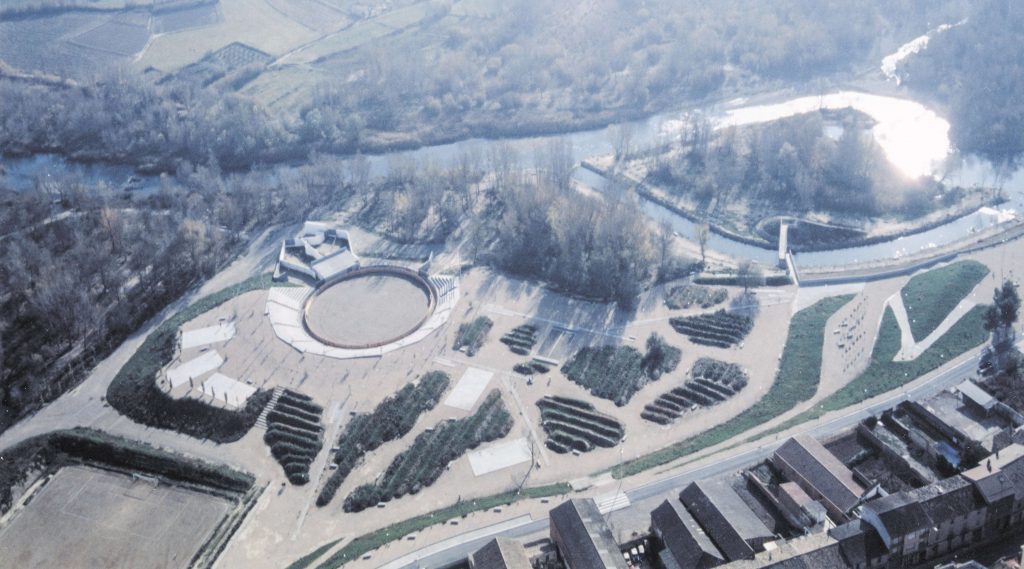Aldayjover Architecture and Landscape was founded in 1996 in the centre of Barcelona, and expanded to the US in 2011. The firm’s work is recognised for its leadership in placing a new focus on the relationship between cities and rivers, as well as the urban integration of industrial infrastructure and transportation.
In its 13 years of professional activity, it has been honoured with international awards on multiple occasions. Among others, it has won the European Prize for Urban Public Space 2002, the FAD Award in City and Landscape 2009, two García Mercadal Awards from the Official School of Architects of Aragon 2001 and 2005, was a two-time finalist in the Spanish biennial of architecture 2005 and 2009 and the European Landscape Prize 2008, the Ibero-American Architecture Biennial 2004 and the FAD Award 2002.
Margarita Jover, an architect specialising in public architecture and landscaping who has received multiple awards for her work in recovering spaces, is one of the partners of aldayjover. At The Decorative Surfaces, we looked back on her career and chatted to her after she was appointed as a Professor at Tulane University in New Orleans, an accomplishment with very few precedents for a Spanish architect.
You are a very renowned architect in the industry; what do you think is the hallmark of your personal brand?
We prefer to think in terms of teams rather than individuals. Our company aldayjover consists of a team of professionals from various disciplines with a collective project whose mission is to work for the benefit of the public. We receive international recognition for the integration and cohabitation of the natural flood dynamics in cities (Aranzadi Park in Pamplona, park of the Expo 2008 in Zaragoza), for the integration of various types of mobility and energy infrastructure in public spaces (Zaragoza tram, “Green Diagonal” in Barcelona, power plant and video art centre) and for projects involving public amenities and social housing. We have specialised in innovation, in what we call “design research”, which means finding solutions to complex problems that the standard approach is not capable of resolving.
Is there a specific project you’d like to highlight based on the impact it has had?
The firm’s first project – the Park of Zuera and bullring amphitheatre – obtained the European Prize for Urban Public Space in 2001 and received a lot of coverage in specialised magazines and even on television, on the RTVE channel “La 2” – titled Escala Humana – las formas del agua.
In this project, we were able to turn certain ideas into reality, a way of understanding the territory, the relationship between nature and humans, the optimisation of resources… Many of these based on intuition but, with a scientific and critical analysis of the results and the technical advances that have been made since, they have ended up becoming the basis for the methodology and philosophy of aldayjover.
At aldayjover, how do you approach your projects?
Our way of working at aldayjover is embedded in several project-based lines of research that came about as a response to the contemporary challenges of climate change and social inequality. There are four of these project-based lines of research: Cities and Rivers; Cities and Infrastructure; Cities, Restoration and Reuse; and Cities and Collective Housing.

Image 1: Power plant and video art centre
As I mentioned before, they’re never simple problems – in fact, they’re complex and compound; we try to resolve them with hybrid responses that seem simple, but have far-reaching social and environmental effects.
What do you like most about the creative process?
The thing that gives me the most satisfaction in the creative process is figuring out how we can solve more problems with fewer resources. We are obsessed with the appropriateness of the project-based response.
Is there anything you think makes your day-to-day work routine easier, anything you’d like to recommend to other architects?
I’m an urban planner architect as well as a professor at the American university. I find enjoyment in everything I do, from giving lectures to drawing, reading, walking, running… Life is short and I want to do it all! As a recommendation, I’d tell architects to try and work less, although it is difficult considering the challenges we face. In fact, I should take my own recommendation.
After a lifetime dedicated to architecture, what’s your motivation to keep going in this industry?
My motivation in general comes from the desire to improve cities, living spaces, etc. To do our bit to contribute to adapting and slowing down climate change and improving the lives of our neighbours – what greater satisfaction than seeing the projects constructed, alive and lived in!

Image 2: Recovery of the Riberas del Gallego hiking route
What role do you think technology plays in your work?
In our projects it is fundamental. Although many of the main ideas have vernacular and/or cultural roots, it’s necessary to reinterpret them and even help them evolve in order to solve our problems. And technology has allowed us to get them up to date. Sometimes this is obvious, but in many other cases, it goes unnoticed at first glance. And that’s also a virtue of technology.
Do you believe technology has made our lives easier?
On a day-to-day basis, technology has made all our lives easier, but also more accelerated. We’ve found a way to work remotely, keep in touch with loved ones who are in other cities, etc., but finding the right presence is difficult but essential.
Do you have a project on the horizon that you can share and would like to talk about?

Image 3: Metropolitan Forest of Madrid
We have various projects on the go, the majority of which involve landscapes and public spaces. I’d emphasise the fact that we’re working on the project of the Metropolitan Forest of Madrid and especially on its intersection with the Manzanares river. A transdisciplinary project focused on recovering habitats in an area that is highly degraded and fragmented due to the infrastructure, tapping into the resources of the location: river water, runoff water and regenerated water from the purifiers; soil, cultural, historical and productive aspects. Enhancing the value and reestablishing the balance of all of these resources is a huge challenge with a massive number of players involved, but will also entail a very positive ecological and social impact in one of the most degraded areas in the capital.
The projects by the architecture firm Aldayjover have been exhibited in the Cité de l’Architecture in Paris and in the NAI in Rotterdam, in addition to receiving numerous international prizes, which have consolidated the firm in the industry due to the commitment, design and efficiency of its projects throughout its thirteen years of professional activity.

